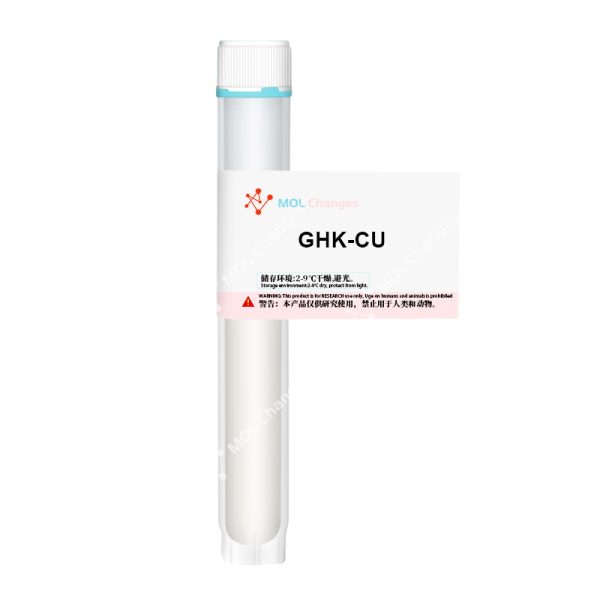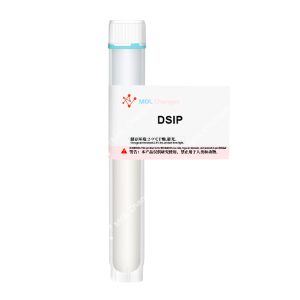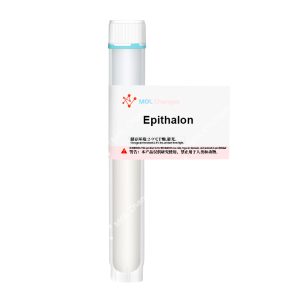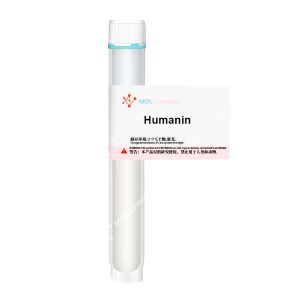GHK Copper Peptide (GHK-Cu Peptide or Copper Peptide) is a spontaneously formed metal complex between the GHK tripeptide and copper(II) ions. X-ray analysis shows that glycine and histidine residues act as ligands binding to the metal cation (Cu²⁺). The side chain of the lysine residue may be involved in recognizing receptors on target skin cells. Copper ions participate in various anti-aging processes through enzyme catalysis.Both components of GHK-Cu – GHK itself and the Cu²⁺ – hold independent, yet complementary, roles in preventing the processes of aging.
Sequence
Gly-His-Lys-Cu
CAS Number
89030-95-5
Molecular Formula
C14H23CuN6O4
Molecular Weight
401.91
Research Of GHK-CU / GHK Copper Peptide
The fundamental difference between GHK and GHK-Cu stems from GHK’s exceptionally high affinity for copper ions. This affinity means that within biological environments containing copper ions, preferential binding occurs; forming the more stable GHK-Cu complex. Conclusively, many if not all, of GHK’s biological functions are mediated by this copper-bound form.
1.Enhanced antioxidant and anti-inflammatory properties
Interleukin 6 (IL-6) is a key cytokine involved in skin inflammation and subsequent wound healing. GHK-Cu reduces the secretion of this cytokine (induced by Tumor necrosis factor / TNF-α). Serving as an alternative to corticosteroids or conventional topical non-steroidal anti-inflammatory drugs, minimizing the potential side effects of longer term use is one of its more valuable properties.
2.Supports connective tissue repair and restructuring
Glycosaminoglycans/GAGs (hyaluronic acid being the prime example) bind large amounts of water, providing the skin with both hydration and fullness that healthy dermal matrix provides.
Extremely low, non-toxic concentrations of GHK-Cu stimulate the synthesis and degradation of these GlycosAminoGlycans/GAGs and collagen. Wound healing, all forms of skin repair, improved texture and enhanced elasticity are all positively influenced.
3.Skin Care and Anti-Aging
GHK-Cu is now incorporated into serums, creams, eye creams etc. It helps to firm the skin, reduces fine lines and wrinkles, while radiance and smoothness of the skin are all at least partially restored. Its application as a treatment leads to a clinically significant improvement in skin physiological function.
4.Hair Care Field
GHK-Cu is being developed as a hair growth and strengthening product. Hair loss (to a certain degree) can be addressed by stimulating the follicle and prolonging the anagen phase of the cycle. Research shows a level of efficacy comparable to minoxidil in these processes.
5.Promoting Neural Regeneration (Neuroregeneration) and Gene Expression
GHK-Cu is at least partially a restorative agent. It influences a wide range of age-related diseases. Clinical and preclinical studies are currently being conducted to test all of the above, and future human therapies may well benefit from this truly natural, small molecule peptide.
6.Summary
GHK-Cu is a small peptide with significant physiological effects on the human body. It is widely used as a hair growth and cosmetic agent, but it is evident that there are additional clinical indications.
The ability to incorporate natural peptides combined with copper into treatments holds great promise for improving patient outcomes in areas such as infection management, wound healing, hair growth, and cognitive function.
COA
HPLC
MS








